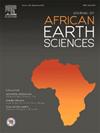Hydrogeochemical and hydrogeological baseline study following the mining of asbestos at the Havelock Mine, Bulembu, eSwatini
IF 2.2
4区 地球科学
Q2 GEOSCIENCES, MULTIDISCIPLINARY
引用次数: 0
Abstract
This study examined the hydrogeological and hydrochemical conditions around Bulembu, eSwatini, two decades post-closure of the Havelock asbestos mine. On-site parameters and water samples underwent chemical and stable isotope analysis, supplemented by flow measurements and tracer tests with NaCl and uranine. Multivariate statistical analysis and PHREEQC modelling identified three water groups: i) low mineralised surface water (32 mg/L TDS), ii) mining-influenced water from the Havelock mine pool (212 mg/L TDS), and iii) tailings seepage water (411 mg/L TDS). All are earth alkaline, hydrogen carbonate-dominant, dominated by Mg and hydrogen carbonate ions. Surface water complies with WHO standards, except for elevated As in the mine pool and Cr in waste rock seepage. Chemical and tracer test results indicate a well-mixed, low-residence-time mine pool. Both the Tutusi river catchment and the upper Nkomazana catchment as well as water courses downstream of the abandoned mine exhibit pristine water quality. The authors propose inclusion of the area in a trans-boundary national park with the Barbeton Makhonjwa Mountains UNESCO World Heritage Site. They recommend amelioration of tailings, not remining, to safeguard the environment and local population from asbestos exposure.

在斯瓦蒂尼Bulembu的Havelock矿开采石棉后进行的水文地球化学和水文地质基线研究
这项研究调查了在Havelock石棉矿关闭20年后,eSwatini的Bulembu周围的水文地质和水化学条件。现场参数和水样进行了化学和稳定同位素分析,并辅以流量测量和NaCl和铀示踪测试。多元统计分析和PHREEQC模型确定了三种水组:1)低矿化地表水(32 mg/L TDS), 2) Havelock矿池开采影响水(212 mg/L TDS), 3)尾矿渗水(411 mg/L TDS)。均为土碱性,以碳酸氢为主,以Mg和碳酸氢离子为主。地表水除矿池砷含量偏高、废石渗水铬含量偏高外,均符合世界卫生组织标准。化学和示踪试验结果表明,这是一个混合良好、停留时间短的矿池。图图西河集水区和上游的恩科马扎纳集水区以及废弃矿井下游的水道都显示出原始的水质。作者建议将该地区与Barbeton Makhonjwa山脉一起列入联合国教科文组织世界遗产的跨境国家公园。他们建议改善尾矿,而不是采矿,以保护环境和当地居民免受石棉的影响。
本文章由计算机程序翻译,如有差异,请以英文原文为准。
求助全文
约1分钟内获得全文
求助全文
来源期刊

Journal of African Earth Sciences
地学-地球科学综合
CiteScore
4.70
自引率
4.30%
发文量
240
审稿时长
12 months
期刊介绍:
The Journal of African Earth Sciences sees itself as the prime geological journal for all aspects of the Earth Sciences about the African plate. Papers dealing with peripheral areas are welcome if they demonstrate a tight link with Africa.
The Journal publishes high quality, peer-reviewed scientific papers. It is devoted primarily to research papers but short communications relating to new developments of broad interest, reviews and book reviews will also be considered. Papers must have international appeal and should present work of more regional than local significance and dealing with well identified and justified scientific questions. Specialised technical papers, analytical or exploration reports must be avoided. Papers on applied geology should preferably be linked to such core disciplines and must be addressed to a more general geoscientific audience.
 求助内容:
求助内容: 应助结果提醒方式:
应助结果提醒方式:


